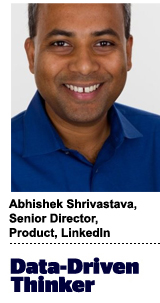“Data-Driven Thinking” is written by members of the media community and contains fresh ideas on the digital revolution in media.
Today’s column is written by Abhishek Shrivastava, senior director of product at LinkedIn.
Recently, I’ve heard from many in the marketing community that they feel a sense of unease. Consumer privacy is changing the game, and they realize it’s time to rebuild digital advertising from the ground up.
The challenge is particularly acute for B2B marketers. B2B deals tend to take six-to-nine months to close, and there is an entire group of decision makers marketers need to influence, not just one individual.
For years, marketers have been limited to leveraging consumer identity and social identity across the web to target potential buyers with the right message at the right time. But with ongoing privacy changes, there is an opportunity for marketers to reimagine how to target potential buyers based upon their professional identity.
What exactly is professional identity? It’s a fresh way of thinking about audience segmentation that builds anonymous groups of professionals based on the role they may play in the purchase process. It’s a combination of data points, such as a person’s role, function, company and level of seniority.
Why differentiating buyer identities is more critical than ever
Before considering a new approach to identity, marketers must pause and think about who they are targeting and why.
Over the years, B2B companies have gotten more sophisticated with how they gain new customers and grow those relationships. Some approaches, including account-based marketing (ABM), have become table stakes for organizations. But many of the tried-and-true methods – such as identifying companies based on IP addresses, a big part of what fuels successful ABM campaigns – will need to change.
Marketers must consider the identity of their buyers and begin differentiating between a consumer identity and a professional identity. Using look-alike audiences created for a B2C world has never been enough to target a B2B buyer and will become even more challenging with loss of signals.
But if B2B marketers can more clearly differentiate between buyer identities and outline the professional identities of their buyers, they will be able to solve three significant challenges facing the digital marketing world: finding buyers, establishing trust and measuring success.
Problem 1: Finding the buyers
Evaluating professional identity – including data points such as company/employer, professional email domain, role/level of seniority, job function, shown interests and buyer intent – is critical in ensuring you’re reaching the right audience and delivering the right message at the right time.
Historically, B2B marketers have been forced to approach their advertising like B2C marketers, as in targeting broadly and measuring success based on ad impressions and clicks.
This doesn’t align with performance-minded goals for B2B marketers who are increasingly seeking digital tools that help them drive their business outcomes. Professional identity moves away from broad and often inaccurate targeting, such as age and gender, and focuses on reaching potential buyers in a category. It includes reaching professionals who could buy today and in the future, as well as non-buying audiences that might choose to partner with a company in other ways.
Being able to zero in on buyer intent is increasingly important to B2B marketers. Here’s why: 20% of buyers are in-market for services in a given year and just 5% in a given quarter. By focusing on buyers who are in-market, B2B advertisers can cut out wasted spend, generate better return on their investment and build more effective audience segments.
Problem 2: Establishing trust through tailored messaging
Understanding your buyer’s professional identity will allow you to create a strategy that builds trust over time, which goes beyond simply putting your ad in front of the right audience.
Far too many B2B buyers (48%) say that sellers deliver misleading information, which is unfortunate, because buyers are twice as likely to be influenced by vendors they believe are transparent. At the same time, if marketers initially approach potential buyers with relevant messaging targeted at them more specifically based on relevant professional attributes, the relationship is off to a trusted start that has a better chance of leading to a long-lasting partnership. Marketers, like anyone else, only have one chance at a first impression.
I predict that marketers will eventually be able to customize messaging for different professional identity groups. For instance, when a software seller wants to zero in on chief marketing officers and VPs of finance at certain companies, those two types of professionals will want to know different things. The CMO will want to know about the product’s marketing features, while the finance exec will put more emphasis on how much it costs.
B2B marketers need to be able to tailor messages for each professional identity. It’s all about finding the right decision-makers at the right companies and communicating with them intelligently.
Problem 3: Measuring B2B marketing more specifically
Until recently, organizations were able to track an individual’s actions across multiple websites to better understand the success of their campaigns.
Recent changes on the privacy landscape mean that level of measurement is no longer consistently available or at the granular individual level marketers have come to expect. For marketers, privacy changes will create an even wider divergence in how audience targeting and measurement is done for B2B versus B2C.
But what may initially present as a challenge is actually a great opportunity for B2B marketers.
To effectively measure B2B marketing moving forward, marketers should better align campaigns to sales outcomes, most notably deals closed, by measuring the efficacy of their marketing at an account level through signals, such as CRM data.
All told, even if B2B marketing is done well, it can take months and months to land a sale. As new privacy policies make data harder to come by, the marketing community should embrace professional identity to make closing deals easier and faster in the future.
Follow LinkedIn (@LinkedIn) and AdExchanger (@adexchanger) on Twitter. Connect with Abhishek Shrivastava on LinkedIn.













